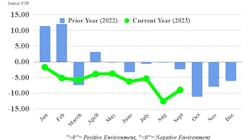FTR: TCI improved in September, but trucking conditions remain tough
FTR’s Trucking Conditions Index improved to -8.97 in September from -12.54 in August, primarily due to more stable fuel prices and modestly more robust freight demand, according to the latest figures released in late November. However, market conditions remain challenging for carriers, and the outlook is for consistently negative TCI readings into late 2024.
“The TCI was less negative in September principally because fuel costs did not rise as much as they did in August, but trucking companies saw no real improvement in freight market conditions,” said Avery Vise, FTR’s VP of trucking. “Although carriers today are seeing some temporary relief due to the recent drop in diesel prices, freight rates look to improve only gradually over the next year. The trucking industry continues to struggle with more capacity than is ideal, given sluggish freight volume. Many operations apparently are hanging on or maintaining driver levels in hopes of a near-term rebound, but that approach amounts to an increasingly high-stakes game of chicken.”
Details of the August forecast are found in the November 2023 issue of FTR’s Trucking Update, published on Oct. 31. The November edition includes additional commentary analyzing the significant Q3 gross domestic product growth—the strongest in nearly two years—and what it might signify for the freight market going forward. The Trucking Update includes data and analysis on load volumes, the capacity environment, rates, and the economy.
See also: Trucking conditions continue to weaken
The TCI tracks the changes representing five primary conditions in the U.S. truck market: freight volumes, freight rates, fleet capacity, fuel prices, and financing costs. The individual metrics are combined into an index indicating the industry’s overall health. A positive score represents good, optimistic conditions. Conversely, a negative score means bad, pessimistic conditions. Readings near zero are consistent with a neutral operating environment, and double-digit readings in either direction suggest significant operational changes are likely.
About the Author
FleetOwner Staff
Our Editorial Team
Kevin Jones, Editorial Director, Commercial Vehicle Group
Josh Fisher, Editor-in-Chief
Jade Brasher, Senior Editor
Jeremy Wolfe, Editor
Jenna Hume, Digital Editor
Eric Van Egeren, Art Director
